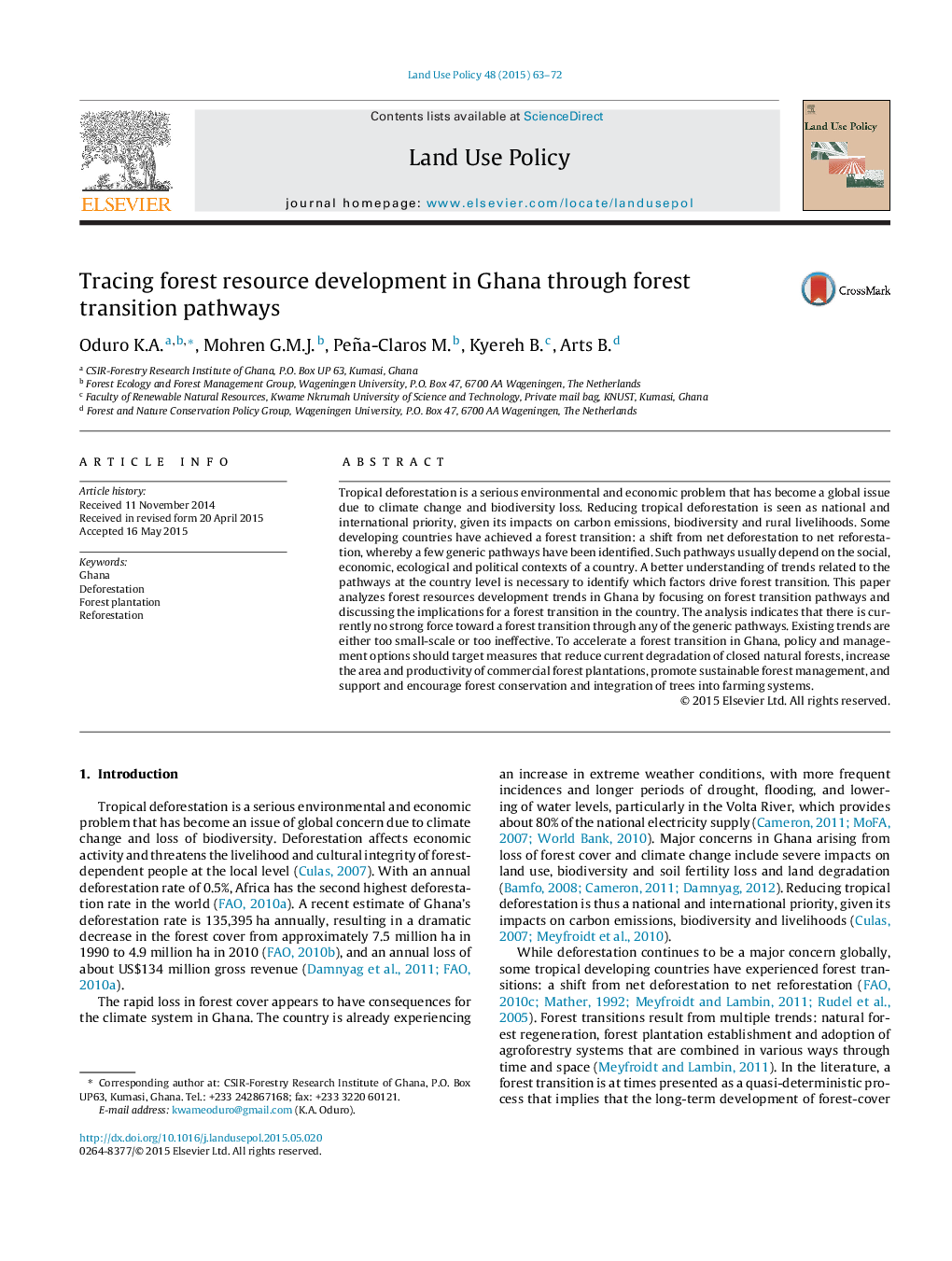| کد مقاله | کد نشریه | سال انتشار | مقاله انگلیسی | نسخه تمام متن |
|---|---|---|---|---|
| 6547888 | 160105 | 2015 | 10 صفحه PDF | دانلود رایگان |
عنوان انگلیسی مقاله ISI
Tracing forest resource development in Ghana through forest transition pathways
ترجمه فارسی عنوان
ردیابی توسعه منابع جنگل در غنا از طریق مسیرهای گذار جنگل
دانلود مقاله + سفارش ترجمه
دانلود مقاله ISI انگلیسی
رایگان برای ایرانیان
کلمات کلیدی
غنا، جنگل زدایی، کاشت جنگل، جنگل زدایی،
ترجمه چکیده
جنگل زدایی گرمسیری یک مشکل جدی محیطی و اقتصادی است که به دلیل تغییرات اقلیمی و از دست رفتن تنوع زیستی به یک مسئله جهانی تبدیل شده است. کاهش جنگل زدایی در مناطق گرمسیری به عنوان اولویت ملی و بین المللی به شمار می رود، با توجه به تاثیرات آن بر انتشار کربن، تنوع زیستی و معیشت های روستایی. برخی از کشورهای در حال توسعه به انتقال جنگل دست یافته اند: تغییر از جنگل زدایی خالص به جنگل زدایی خالص، که در آن چند مسیر عمومی مشخص شده است. چنین مسیرهایی معمولا به شرایط اجتماعی، اقتصادی، محیطی و سیاسی یک کشور بستگی دارد. درک بهتر از روند مربوط به مسیرها در سطح کشور لازم است تا مشخص شود کدام عوامل باعث انتقال جنگل ها می شوند. این مقاله به بررسی روند توسعه منابع جنگل در غنا با تمرکز بر مسیرهای انتقال جنگل و بحث در مورد پیامدهای انتقال جنگل در کشور می پردازد. تجزیه و تحلیل نشان می دهد که در حال حاضر نیروی قوی برای انتقال جنگل از طریق هر یک از مسیرهای عمومی وجود ندارد. روندهای موجود یا اندکی در مقیاس و یا بی فایده هستند. برای سرعت بخشیدن به انتقال جنگل ها در غنا، گزینه های سیاست و مدیریت باید اقداماتی را که باعث کاهش تخریب فعلی جنگل های بسته شده، افزایش سطح و بهره وری از جنگل های تجاری تجاری، ترویج مدیریت جنگل های پایدار و حمایت و حمایت از حفاظت جنگل و ادغام درختان سیستم های کشاورزی
موضوعات مرتبط
علوم زیستی و بیوفناوری
علوم کشاورزی و بیولوژیک
جنگلداری
چکیده انگلیسی
Tropical deforestation is a serious environmental and economic problem that has become a global issue due to climate change and biodiversity loss. Reducing tropical deforestation is seen as national and international priority, given its impacts on carbon emissions, biodiversity and rural livelihoods. Some developing countries have achieved a forest transition: a shift from net deforestation to net reforestation, whereby a few generic pathways have been identified. Such pathways usually depend on the social, economic, ecological and political contexts of a country. A better understanding of trends related to the pathways at the country level is necessary to identify which factors drive forest transition. This paper analyzes forest resources development trends in Ghana by focusing on forest transition pathways and discussing the implications for a forest transition in the country. The analysis indicates that there is currently no strong force toward a forest transition through any of the generic pathways. Existing trends are either too small-scale or too ineffective. To accelerate a forest transition in Ghana, policy and management options should target measures that reduce current degradation of closed natural forests, increase the area and productivity of commercial forest plantations, promote sustainable forest management, and support and encourage forest conservation and integration of trees into farming systems.
ناشر
Database: Elsevier - ScienceDirect (ساینس دایرکت)
Journal: Land Use Policy - Volume 48, November 2015, Pages 63-72
Journal: Land Use Policy - Volume 48, November 2015, Pages 63-72
نویسندگان
Oduro K.A., Mohren G.M.J., Peña-Claros M., Kyereh B., Arts B.,
